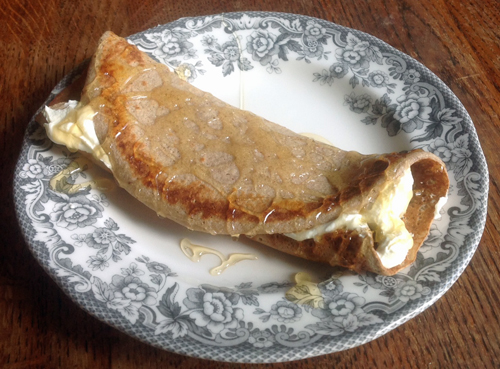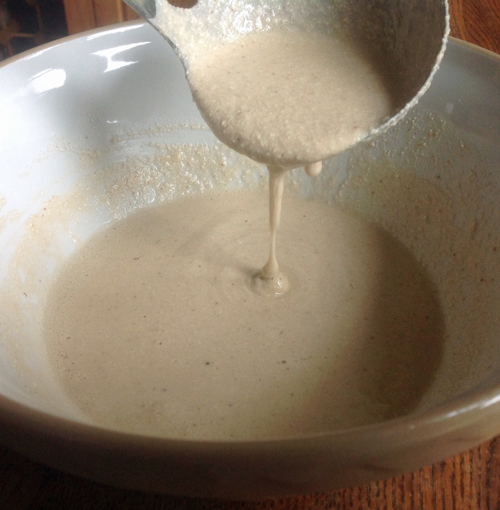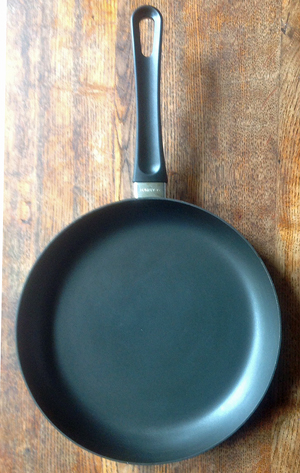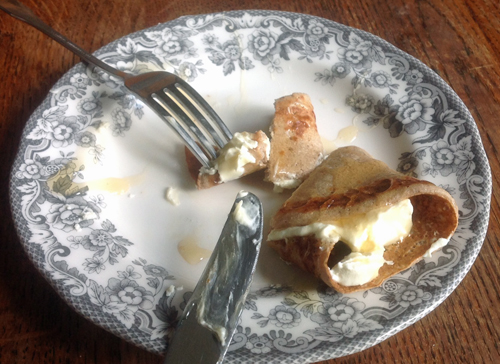Necci are traditional chestnut flour crêpes made in the sweet chestnut growing area of northern Tuscany. Typically they are filled with ricotta, sometimes sweetened with honey. I made these for Pancake Day (Shrove Tuesday), reporting on my first attempts in my post In My Pancake Kitchen, but they were so good (as you can see in the photo), that I thought I should make them again and post on them separately.
An interesting description of making traditional necci can be found on the blog Bella Bagni di Lucca, a magazine-style blog about Bagni di Lucca, a village in Tuscany, in the wooded hillls just Northeast of the larger town of Lucca. Their post Making necci highlights chestnut pancake making at various Tuscan food festivals.
It was after seeing that blog, I became keen on making my own necci (which, by the way, are gluten free). So, I scoured all Italian food shops and delis in the surrounding area, but couldn’t locate a single precious bag of Farina di Castagna. Result: internet search which led me to Shipton Mill in Gloucestershire. Their ancient mill stone grinds all sorts of lovely organic flours and conveniently has an on-line shop (sadly, UK only) as well as a members section devoted to sharing baking recipes. I’ll certainly be returning to this site and perhaps when we’re down South again, pop in for a visit.
Among the non-wheat flours milled at at Shipton Mill is a chestnut flour. It is ground from imported French sweet chestnuts. So, in effect, my necci are a multi-cultural British-French-Italian effort!
Necci
These make a delicious dessert. The contrasting textures of slightly nutty pancakes and creamy cheese filling are set to perfection with a little – but not too much – sweetness from the drizzled honey.
Pancakes (makes about 10)
- 2 cups Chestnut flour
- 2 cups Water
- 1 teaspoon Salt
- 2 eggs
- 2 Tablespoons Olive oil
Filling & Finish
- 1 cup Ricotta
- 1 cup Marscarpone
- Honey
Whisk all the pancake ingredients in a large bowl until smooth. The batter will be slightly grainy due to the nature of the flour. Cover the bowl and let the batter sit for at least an hour. While the batter rests, make the filling.
In a bowl, mix the ricotta and marcarpone for the filling until well blended. If using homemade ricotta-marsarpone (see my post Repurpose the Whey), you can skip this step, remembering that the overall quantity should be 2 cups.
Traditionally, necci are made sandwiched between two flat cast iron paddles, set over an open fire or are stacked between flat rocks lined with chestnut leaves – the techniques are shown in Bella Bagni di Lucca’s post Making necci. However, few of us have these specialist bits of necci making equipment, so a good non-stick frying pan is essential. Although…those iron paddles are definitely something I might look out for next time we’re in Tuscany.
Prepare your griddle or non-stick fry pan by greasing it with a little olive oil and placing it on a medium-high heat. I use my 26cm diameter Danish ScanPan frying pan, which you can see in the image above. Ladle on about 1/2 cup batter, quickly rolling your pan to produce a thin round pancake approximately 8 inches in diameter.
When the pancake edges begin to show a little color and the top looks dry, gently loosen it from the bottom of the pan around the edges until the pancake moves when you shake the pan. Be warned, the pancakes are fragile at this stage and I can imagine that this is why they are traditionally sandwiched between two cast iron paddles – easier to handle when turning. Check the color on the bottom and if it is acquiring golden highlights, shift it out onto a waiting plate before flipping it back into the pan. Cook until the other side matches the cooked one.
All the pancakes can be made first before filling as you will need the pancakes to be slightly warm and not hot right out of the pan. On each pancake, liberally smear one side (1/3 of the pancake) with the ricotta-mascarpone, fold this over into the middle and smear more of the cheese before folding the other side over this. Plate up and drizzle with a little honey. Serve and enjoy!
Note: It is best to buy chestnut flour in small quantities since it does not keep as well as other flours. I store any remaining flour I have in the refrigerator.










Oh wow! The chestnut flour, the cheese filling, what a lovely combination!! The flour sounds great, I’d love to try it x
LikeLike
Really, really good. And, Shipton Mill is an excellent source for all sorts of flours.
LikeLike
It looks like such a great place 🙂
LikeLike
Yes, it is!
LikeLike
I’ve ordered from them online!!! 🙂
LikeLike
Excellent!
LikeLike
Delicious! I know where I can buy chestnut flour (at a high price) but these sound delicious, so hang the expense! Good GF breakfast food for me!
LikeLike
I’m sure you won’t be disappointed. They’re really very good, although it took a few goes before I got the hang of turning the darn things! I started looking at holiday lets in Garfagnana, so I may find those cast iron necci paddles yet.
LikeLike
Your necci look great!
LikeLike
Thanks so much! I love your blog and the necci making was very informative! Makes me want to plan our next holiday in Garfanagna!
LikeLike
These look delicious!
LikeLike
They were! We had them as a dessert, but I suppose they would make a really good – luxurious- weekend breakfast.
LikeLike
Wow, very nice!
LikeLike
If you can get chestnut flour, you should try them. I can’t praise them high enough.
LikeLike
We just watched an Ottolenghi tv episode where he visited Corsica (always wanted to go there), and chestnut flour was used all over the place in the local cuisine. I love chestnuts, but have never used, or even tasted, chestnut flour. Yourself and Ottolenghi have inspired me!
LikeLike
Wow! I’ll have to look closer at Corsican food. I’m trying find a light chestnut cake recipe, not the traditional Tuscan one that is a bit dense and studded with fruit and nuts – not really a spring sort of cake. I wish I could have seen that tv episode. Sounds interesting.
LikeLike
It’s on 4oD, if you search for the series ‘Ottolenghi’s Mediterranean Feast’ 🙂
LikeLike
Thanks!
LikeLike
These look beautiful, I haven’t seen organic chestnut flour around these here parts but I shall try to track some down so I can make these.
LikeLike
If you can find chestnut flour, the pancakes are worth it! Another good gluten free flour.
LikeLike
These look incredible! Love the filling and use of chestnut flour here! I bet they’re delicious.
LikeLike
They were certainly delicious! They are definitely something I would make again. I loved the chestnut flour so much I’m looking into other uses for it – traditionally in cakes, but also as a pasta.
LikeLike
Those look fab! and I haven’t had breakfast yet, wanna send some?
LikeLike
I wish I could! They are (were) fab. If you can get chestnut flour, why not give them a try?
LikeLike
I think I may just do that!
LikeLike
I love them! And your look delicious!
LikeLike
They were incredibly delicious!
LikeLike
These look deliciously scrumptious! I have to ashamedly admit that I’m not familiar with necci but Iove anything chestnut-y so I’m sure I’ll love these beauties. Guess I have to find where to buy chestnut flour in my neck of the woods.
LikeLike
They’re delicious and I hope you can find chestnut flour. Definitely worth it!
LikeLike
I agree, they are delicious! Maybe I should stash a bag of flour in my packing case for home now you mention it.
LikeLike
Good idea!
LikeLike
I adore tuscany and i tried necci! Well proposed! 🙂
LikeLike
Absolutely delicious. I really love Garfagnana and the chestnut producing area of Tuscany.
LikeLike
[…] Witch’s recent recipe for ‘Necci’ traditional chestnut flour pancakes from My Kitchen Witch made with gluten free chestnut flour. It’s a naturally sweet flour so therefore sugar […]
LikeLike